Difference between revisions of "Shrunken leather - leather shrinkage"
| Line 20: | Line 20: | ||
| − | Welle [[Oils & fats in the leather industry|oiled and greased]] leather will never shrink as quickly as poorly [[leather care|maintained]] leather. The [[tanning leather|tanning methode]] of the leather directly influences its shrinkability. Traditionally [[ | + | Welle [[Oils & fats in the leather industry|oiled and greased]] leather will never shrink as quickly as poorly [[leather care|maintained]] leather. The [[tanning leather|tanning methode]] of the leather directly influences its shrinkability. Traditionally [[vegetable-tanned leather]] already begin to shrink at 70 degrees Celsius. This looks like a high temperature, but which is reached quickly, when a convertible with wet, dark leather seats is put into the sun for drying. The leather is then "cooked" and shrinks. Modern tanning processes, such as [[Chrome tanned|chrome tanning]], raise the threshold of leather shrinkage so that such leather starts shrinking between 85 to 110 degrees Celsius. |
| Line 30: | Line 30: | ||
|- | |- | ||
| bgcolor=#ffffff align=center | [[Rawhide]] | | bgcolor=#ffffff align=center | [[Rawhide]] | ||
| − | | bgcolor=#ffffff align=center | 60°C - 65°C | + | | bgcolor=#ffffff align=center | 60°C - 65°C (140 - 149 °F) |
|- | |- | ||
| bgcolor=#ffffff align=center | After [[pickling]] before [[tanning leather|tanning]] | | bgcolor=#ffffff align=center | After [[pickling]] before [[tanning leather|tanning]] | ||
| − | | bgcolor=#ffffff align=center | 40°C - 60°C | + | | bgcolor=#ffffff align=center | 40°C - 60°C (104 - 140 °F) |
|- | |- | ||
| bgcolor=#ffffff align=center | [[Vegetable-tanned leather]] | | bgcolor=#ffffff align=center | [[Vegetable-tanned leather]] | ||
| − | | bgcolor=#ffffff align=center | 70°C - 80°C | + | | bgcolor=#ffffff align=center | 70°C - 80°C (158 - 176 °F) |
|- | |- | ||
| bgcolor=#ffffff align=center | [[Chrome tanned|Chrome tanned]] | | bgcolor=#ffffff align=center | [[Chrome tanned|Chrome tanned]] | ||
| − | | bgcolor=#ffffff align=center | 85°C - 100°C | + | | bgcolor=#ffffff align=center | 85°C - 100°C (185 - 212 °F) |
|- | |- | ||
| bgcolor=#ffffff align=center | [[Synthetic tanned]] | | bgcolor=#ffffff align=center | [[Synthetic tanned]] | ||
| − | | bgcolor=#ffffff align=center | 75°C - 85°C | + | | bgcolor=#ffffff align=center | 75°C - 85°C (167 - 185 °F) |
|- | |- | ||
| bgcolor=#ffffff align=center | [[Chamois leather]] | | bgcolor=#ffffff align=center | [[Chamois leather]] | ||
| − | | bgcolor=#ffffff align=center | 60°C - 70°C | + | | bgcolor=#ffffff align=center | 60°C - 70°C (104 - 158 °F) |
|} | |} | ||
</center> | </center> | ||
Revision as of 14:44, 12 February 2017
Contents
Shrinkage of leather caused by heat
Leather can shrink and harden by excessive heat. Typical is damaged car leather at the top along the rear bench, the headrests and on dashboards. Leather also hardens because it dries out with time (without leather care). The leather fibers stiffen and become brittle.
This process is accelerated by the fact that the collagen of the fibers then denatures with release of the water previously bound in them. Initially, small singulated thickenings are formed in the leather fibre struccture, which subsequently expand and solidify. The density of the leather increases, but its dimensions decrease. This hardening is extremely stable. Once shrunken leather is therefore irreparably damaged and can sometiems be softened a little with appropriate care products, but the loss of surface is permanent and can not be recovered.
For wet leathers, even little heat is sufficient to shrink it. Wet leather should never be allowed to dry in the sun or on a heater. The best temperature to dry leather is normal room temperature.
Video about the shrinkage of leather.
Welle oiled and greased leather will never shrink as quickly as poorly maintained leather. The tanning methode of the leather directly influences its shrinkability. Traditionally vegetable-tanned leather already begin to shrink at 70 degrees Celsius. This looks like a high temperature, but which is reached quickly, when a convertible with wet, dark leather seats is put into the sun for drying. The leather is then "cooked" and shrinks. Modern tanning processes, such as chrome tanning, raise the threshold of leather shrinkage so that such leather starts shrinking between 85 to 110 degrees Celsius.
| Condition/tanning methode | Shrinkage temperature |
|---|---|
| Rawhide | 60°C - 65°C (140 - 149 °F) |
| After pickling before tanning | 40°C - 60°C (104 - 140 °F) |
| Vegetable-tanned leather | 70°C - 80°C (158 - 176 °F) |
| Chrome tanned | 85°C - 100°C (185 - 212 °F) |
| Synthetic tanned | 75°C - 85°C (167 - 185 °F) |
| Chamois leather | 60°C - 70°C (104 - 158 °F) |
Bemerkenswert ist hierbei jedoch, dass Chromleder zwar später schrumpfen als chromfrei gegerbte Leder - dann jedoch deutlich stärker. Synthetisch gegerbte Leder beispielsweise schrumpfen zwar bereits ab 75 Grad Celsius, werden sich dann jedoch nicht so ausgeprägt zusammenziehen wie Chromleder.
A problem of chrome-free (FOC) synthetic tanned leather is the sensitivity to moisture in the leather plus heat. Approx. 50% of all car leather is FOC. If a convertible comes into the rain, a liquid runs out or a wet towel or a wet swim suit remains too long on the leather, moisture migrates through the finish, the seam holes or the perforation holes. If sun shines on such wet leather, the matrix water (chemically bound in leather) starts boiling and the leather hardens and shrinks.
Shrinkage of synthetic tanned car leather due to moisture in leather and the heat of the sun.
The moisture of leather also has an effect on the shrinkage temperature. Dry leather is more stable than wet leather. Since leather absorbs the surrounding air humidity, the parameter "moisture" must be considered in critical applications of leather.
Die Feuchtigkeit eines Leders hat auch einen Einfluss auf die Schrumpftemperatur. Trockene Leder sind temperaturstabiler als feuchte Leder. Da Leder die umgebende Luftfeuchtigkeit aufnimmt, muss der Parameter „Feuchtigkeit“ bei kritischen Einsatzzwecken des Leders mit beachtet werden.
Rückbank oben bei einem Oldtimer. - Geschrumpftes Armaturenbrett vom Peugeot 307CC.
Kopfstütze durch Sonne geschrumpft. - Brandloch im Sofa durch gefallene Lampe.
Bereits während des Gerbvorgangs selbst muss die Temperatur, der das Leder ausgesetzt wird, ständig kontrolliert werden. Rohhäute und Blößen beispielsweise sollten nicht mit mehr als 30 Grad Celsius konfrontiert werden, da ihre Stabilität gegenüber Temperatureinflüssen noch gering ist. Während der Gerbung selbst wird generell der Temperaturbereich von 50 bis 70 Grad Celsius eingehalten. Weiterhin ist die Temperatur zu überwachen bei der Trocknung, der Zurichtung sowie dem Prägen des Leders.
Die Rückbank vom BMW E30 Cabrio ist besonders anfällig für Hitzeschäden
Unerklärliche Schrumpfung nur einzelner Felder auf der Rückbank eines Volvos. Linkes Bild: Nur hintere Fläche Sitz. - Rechtes Bild: Geräuschvoll aufgeplatztes Leder im Rückenpolster.
Links: Nicht selten: Halogenlampe. - Rechts: Ausgelaufene Flüssigkeit. Das Ziehen der Falten zur Schrumpfstelle ist typisch.
Bei Stoff hätte das Haus gebrannt. Hitzeschaden im Leder durch Rotlichtlampe.
Cockpit-Leder - Armaturenbrett-Leder - Pre-Shrunk Leather
Automobilhersteller und deren Zulieferer machen sich das Schrumpfungsverhalten von Leder übrigens zunutze - etwa zur Verkleidung von Armaturenbrettern. Um einerseits Formstabilität am zu verkleidenden Gegenstand zu erreichen und andererseits zu gewährleisten, dass das Leder auch unter den Praxisbedingungen im Auto (Sonneneinstrahlung und ggf. hohe Luftfeuchtigkeit!) stabil bleibt, wird das Leder in der Produktion manchmal "vorgeschrumpft" (Pre-shrunk leather). Dieses sogenannte heat setting wird durchgeführt, indem das Leder für kurze Zeit Temperaturen von mehr als 100 Grad Celsius ausgesetzt wird - lang genug, um eine dauerhafte Form zu erzielen, aber auch ausreichend kurz, damit das Leder nicht unbrauchbar wird.
Armaturenbrett komplett mit Leder bezogen.
Auch der eingesetzte Kleber spielt eine wichtige Rolle. Der Kleber muss fester sein als die Kräfte bei der Schrumpfung des Leders. auch dann kommt es nicht zu Schäden.
Geschrumpfte Armaturenbretter vom Peugeot 307CC
Shrinkage of leather in the tannery
Since leather is sold by surface, the tanner tries to get an as large as possible hide by the tanning process. However, leathers are sometimes deliberately shrunken, so that the leather becomes thicker and the grain pattern is reenforced. Such treatments are known in the case of cow neck leather and sheep leather. The company www.brocantique.de is a specialist for vegetal tanned sheep leather shrinkage. When shrinking sheep leather, it loses up to 20% of the surface and becomes thicker.
Shrunken sheep leather (www.brocantique.de).
Additional information
![]() -> COLOURLOCK - THE TREATMENT OF HARDENED LEATHER
-> COLOURLOCK - THE TREATMENT OF HARDENED LEATHER







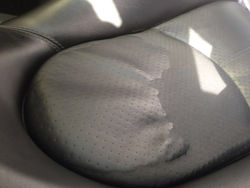
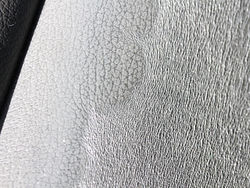
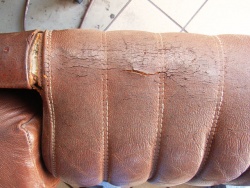
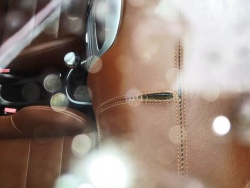
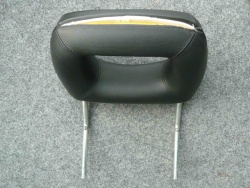
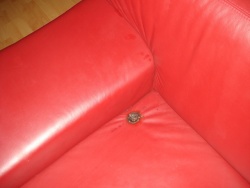
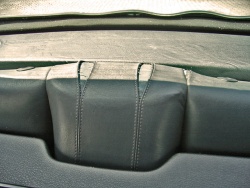
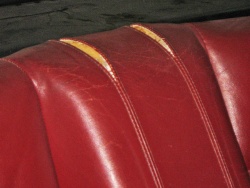
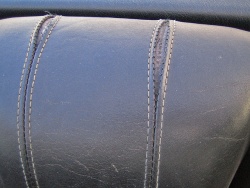
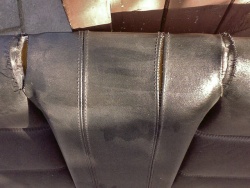
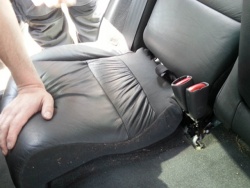
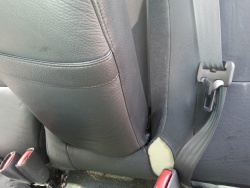
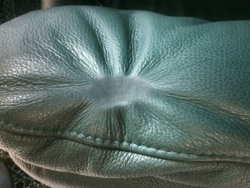
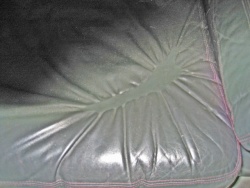
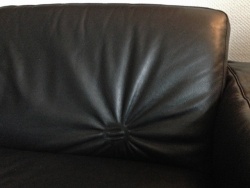
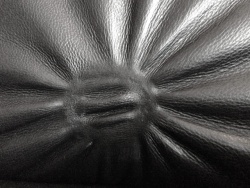
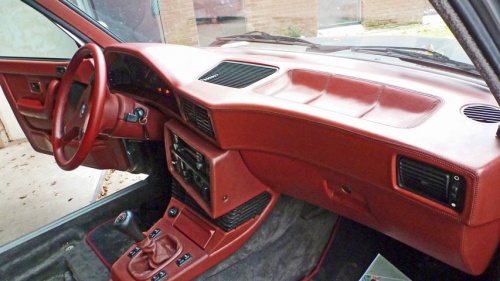
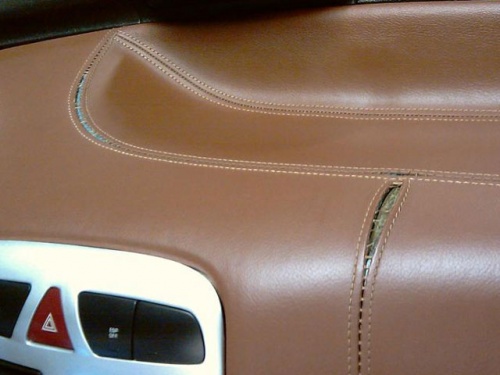
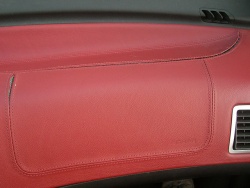
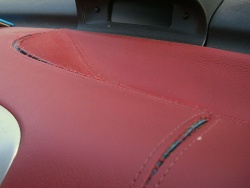
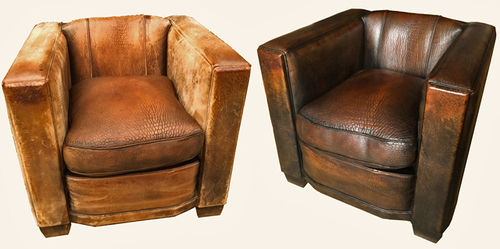

 a kotori web solution
a kotori web solution